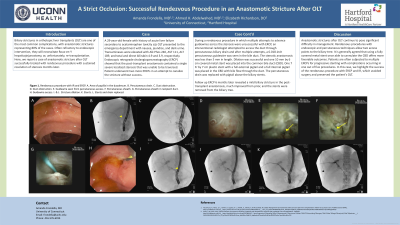Sunday Poster Session
Category: Biliary/Pancreas
P0145 - A Strict Occlusion: Successful Rendezvous Procedure in an Anastomotic Stricture After OLT
Sunday, October 27, 2024
3:30 PM - 7:00 PM ET
Location: Exhibit Hall E

Has Audio

Amanda Frondella, MD
UConn John Dempsey Hospital
Farmington, CT
Presenting Author(s)
Amanda Frondella, MD1, Ahmed H. Abdelwahed, MD2, Elizabeth Richardson, DO3
1UConn John Dempsey Hospital, Farmington, CT; 2University of Connecticut Health Center, Conneticut, CT; 3Hartford Hospital, Hartford, CT
Introduction: Biliary strictures in orthotopic liver transplants (OLT) are one of the most common complications, with anastomotic strictures representing 80% of the cases. Often refractory to endoscopic intervention, they will necessitate Roux-en-Y hepaticojejunostomy, or, unfortunately, re-transplantation. Here, we report a case of anastomotic stricture after OLT successfully treated with rendezvous procedure with sustained resolution of stenosis months later.
Case Description/Methods: A 29-year-old female with history of acute liver failure secondary to acetaminophen toxicity s/p OLT presented to the emergency department with nausea, jaundice, and dark urine. Transaminases were elevated with Alk Phos 240, AST 111, ALT 189, and total and direct bilirubin 4.9 and 3.9, respectively. Endoscopic retrograde cholangiopancreatography (ERCP) showed that the post-transplant anastomosis contained a single severe localized stenosis that was unable to be traversed. Patient underwent two more ERCPs in an attempt to canalize the stricture without success.
During a rendezvous procedure in which multiple attempts to advance guidewires across the stenosis were unsuccessful with ERCP, an interventional radiologist (IR) attempted to access the duct through percutaneous biliary drain and after multiple attempts, a 0.018-inch percutaneous guidewire was seen in the bile duct. The stenotic anastomosis was less than 5 mm in length. Dilation was successful and one 10 mm by 6 cm covered metal stent was placed into the common bile duct (CBD). One 7 Fr by 7 cm plastic stent with a full external pigtail and a full internal pigtail was placed in the CBD with bile flow through the duct. The percutaneous drain was replaced with pigtail above the biliary stents.
Follow up ERCP 6 months later revealed a mild biliary stricture in the post-transplant anastomosis, much improved from prior, and the stents were removed from the biliary tree.
Discussion: Anastomotic strictures after OLT continue to pose significant difficulty in management. Rendezvous procedures with endoscopic and percutaneous techniques allow two access points to the biliary tree. It is generally agreed that using a fully covered metal stent once able to cannulate the CBD offers more favorable outcomes. Patients are often subjected to multiple ERCPs for progressive stenting with complications occurring in one out of five procedures. In this case, we highlight the success of the rendezvous procedure with ERCP and IR, which avoided surgery and preserved the patient’s OLT.
Disclosures:
Amanda Frondella, MD1, Ahmed H. Abdelwahed, MD2, Elizabeth Richardson, DO3. P0145 - A Strict Occlusion: Successful Rendezvous Procedure in an Anastomotic Stricture After OLT, ACG 2024 Annual Scientific Meeting Abstracts. Philadelphia, PA: American College of Gastroenterology.
1UConn John Dempsey Hospital, Farmington, CT; 2University of Connecticut Health Center, Conneticut, CT; 3Hartford Hospital, Hartford, CT
Introduction: Biliary strictures in orthotopic liver transplants (OLT) are one of the most common complications, with anastomotic strictures representing 80% of the cases. Often refractory to endoscopic intervention, they will necessitate Roux-en-Y hepaticojejunostomy, or, unfortunately, re-transplantation. Here, we report a case of anastomotic stricture after OLT successfully treated with rendezvous procedure with sustained resolution of stenosis months later.
Case Description/Methods: A 29-year-old female with history of acute liver failure secondary to acetaminophen toxicity s/p OLT presented to the emergency department with nausea, jaundice, and dark urine. Transaminases were elevated with Alk Phos 240, AST 111, ALT 189, and total and direct bilirubin 4.9 and 3.9, respectively. Endoscopic retrograde cholangiopancreatography (ERCP) showed that the post-transplant anastomosis contained a single severe localized stenosis that was unable to be traversed. Patient underwent two more ERCPs in an attempt to canalize the stricture without success.
During a rendezvous procedure in which multiple attempts to advance guidewires across the stenosis were unsuccessful with ERCP, an interventional radiologist (IR) attempted to access the duct through percutaneous biliary drain and after multiple attempts, a 0.018-inch percutaneous guidewire was seen in the bile duct. The stenotic anastomosis was less than 5 mm in length. Dilation was successful and one 10 mm by 6 cm covered metal stent was placed into the common bile duct (CBD). One 7 Fr by 7 cm plastic stent with a full external pigtail and a full internal pigtail was placed in the CBD with bile flow through the duct. The percutaneous drain was replaced with pigtail above the biliary stents.
Follow up ERCP 6 months later revealed a mild biliary stricture in the post-transplant anastomosis, much improved from prior, and the stents were removed from the biliary tree.
Discussion: Anastomotic strictures after OLT continue to pose significant difficulty in management. Rendezvous procedures with endoscopic and percutaneous techniques allow two access points to the biliary tree. It is generally agreed that using a fully covered metal stent once able to cannulate the CBD offers more favorable outcomes. Patients are often subjected to multiple ERCPs for progressive stenting with complications occurring in one out of five procedures. In this case, we highlight the success of the rendezvous procedure with ERCP and IR, which avoided surgery and preserved the patient’s OLT.
Disclosures:
Amanda Frondella indicated no relevant financial relationships.
Ahmed Abdelwahed indicated no relevant financial relationships.
Elizabeth Richardson indicated no relevant financial relationships.
Amanda Frondella, MD1, Ahmed H. Abdelwahed, MD2, Elizabeth Richardson, DO3. P0145 - A Strict Occlusion: Successful Rendezvous Procedure in an Anastomotic Stricture After OLT, ACG 2024 Annual Scientific Meeting Abstracts. Philadelphia, PA: American College of Gastroenterology.
